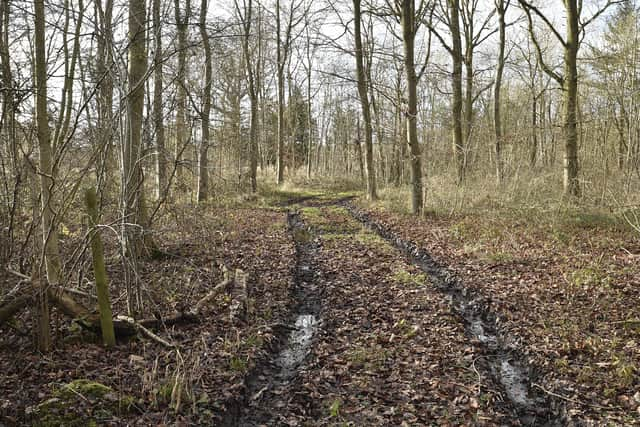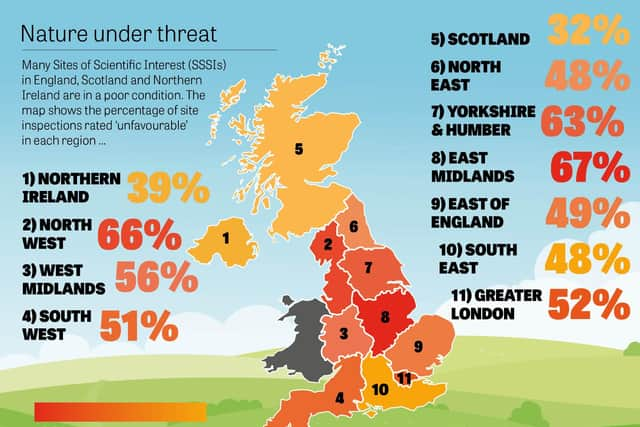Peterborough conservation areas in poor state
and live on Freeview channel 276
Some of the city’s Sites of Special Scientific Interest (SSSIs) are in an unsatisfactory condition, according to official inspections.
Many have also not been assessed for years, leading environmental campaigners to fear that the situation could be even worse.
Advertisement
Hide AdAdvertisement
Hide AdAcross the UK thousands of SSSIs are in a poor state, findings which wildlife charities have branded “shocking”.


SSSIs are protected areas for nature conservation and can cover anything from breeding grounds for rare species to peatland.
In Peterborough, several places currently have all or part of their site rated as being in an “unfavourable” condition.
These includes Dogsthorpe Star Pit, Southorpe Paddock, Southorpe Roughs, Sutton Heath and Bog and Wansford Pasture.
Advertisement
Hide AdAdvertisement
Hide AdOther sites have parts of their land rated as “favourable” and others rated as “unfavourable”.


These include Castor Flood Meadows and Castor Hanglands, Holme Fen near Peterborough, Nene Washes and Orton Pit.
Barnack Hills and Holes, Eye Gravel Pit and Southorpe Meadow are rated as being in a “favourable” condition, although the last inspections go back up to 12 years.
Across the UK, half of the most recent inspections of protected land or natural features found poor conditions or the destruction of habitats.
This includes:
Advertisement
Hide AdAdvertisement
Hide Ad. A colony of puffins on the Shetland Islands’ Sumburgh Head in an unsatisfactory and declining state, with the situation blamed on climate change
. All protected sections of Cornwall’s famous Bodmin Moor assessed as being in an unfavourable condition.
Paul de Zylva of Friends of the Earth said it was “shocking that our top wildlife sites are in such poor condition”.
He said: “If we can’t even protect the jewels in the crown it’s little wonder that UK nature is in such poor shape.
Advertisement
Hide AdAdvertisement
Hide Ad“The new government must make the protection and restoration of our natural environment a top priority.”
Nikki Williams, the Wildlife Trust’s director of campaigns and policy, said bodies such as Natural England, which monitor the condition of sites, had been starved of funding.
She called for them to get a substantial cash injection “to enable them to carry out their functions effectively and to ensure our protected sites are restored and enhanced”.
In England, SSSIs are inspected in smaller sections called units. More than half of these units (53 per cent) are in an unfavourable condition, inspection data shows.
Advertisement
Hide AdAdvertisement
Hide AdThe picture is worst in the East Midlands and the North East where two-thirds of inspected areas are rated unfavourable.
Guidelines state SSSI features in England should be assessed at least every six years, but analysis found more than half (12,394) of sites have not been assessed since 2011.
A spokesperson for the Department for Environment, Food and Rural Affairs (DEFRA) said that while most of England’s SSSIs were either in a favourable condition or were recovering, they recognised that “more needs to be done to improve these vital sites”.
“That’s why we are focusing on restoring those sites that are still in a recovering condition so we can enhance these important areas,” the spokesperson said.
What is a Site of Special Scientific Interest?
Advertisement
Hide AdAdvertisement
Hide AdSites of Special Scientific Interest (or Areas of Special Scientific Interest in Northern Ireland) are protected areas for nature conservation. Most are in private ownership, as part of estates, forests or farms.
They are chosen to be SSSIs by the four UK Country Nature Conservation Bodies: Natural England, Scottish Natural Heritage, the Northern Ireland Environment Agency and Natural Resources Wales.
SSSIs/ASSIs are chosen because they are home to rare plant or animal species or important geographical features. A site can have more than one feature of interest.
In England, SSSIs are divided into smaller areas called units with 21,320 of having had a condition assessment.
Of these:
Advertisement
Hide AdAdvertisement
Hide Ad. 11,306 units (53 per cent) are in an unfavourable condition
. 9,927 units (47 per cent) are in a favourable condition
. 87 units (less than one per cent) are destroyed.
The data in this article is correct as of December 6, 2019.